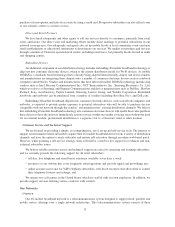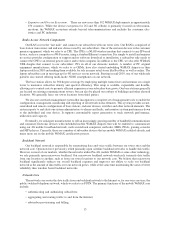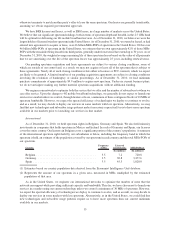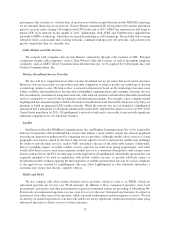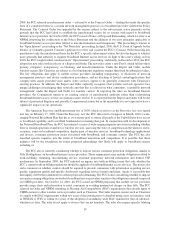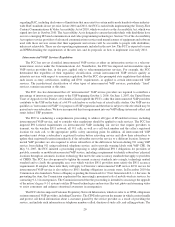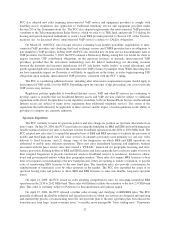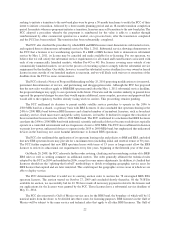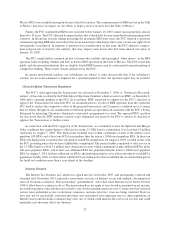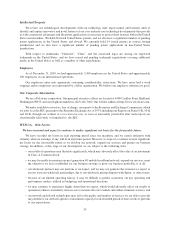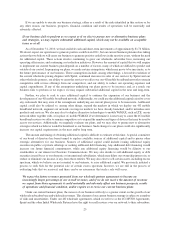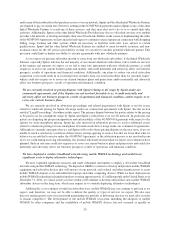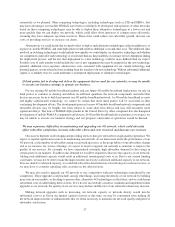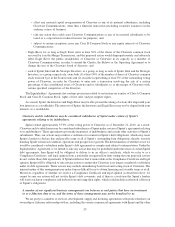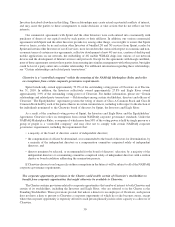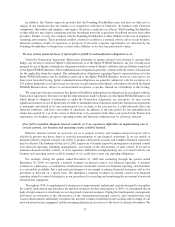Clearwire 2010 Annual Report Download - page 26
Download and view the complete annual report
Please find page 26 of the 2010 Clearwire annual report below. You can navigate through the pages in the report by either clicking on the pages listed below, or by using the keyword search tool below to find specific information within the annual report.FCC also adopted new rules requiring interconnected VoIP service and equipment providers to comply with
disability-access regulations also applicable to traditional telephony service and equipment providers under
Section 255 of the Communications Act. The FCC also adopted requirements that interconnected VoIP providers
contribute to the Telecommunications Relay Service, which we refer to as TRS, fund, and provide 711-dialing for
hearing and speech-impaired individuals to reach a local TRS provider pursuant to Section 225 of the Commu-
nications Act. As discussed above, interconnected VoIP service is subject to CALEA obligations.
On March 24, 2008 FCC rules became effective extending local number portability requirements to inter-
connected VoIP providers and clarifying that local exchange carriers and CMRS providers have an obligation to
port numbers to VoIP providers. In May 2009, the FCC also extended new 24-hour service discontinuance rules to
VoIP providers. On November 5, 2010, the FCC released a Declaratory Ruling stating that it is lawful for states to
impose intrastate USF contribution obligations on the intrastate revenues of nomadic interconnected VoIP
providers, provided that the assessment methodology uses the federal methodology for allocating revenues
between the interstate and intrastate jurisdictions (64.9% safe harbor, traffic studies, or actual allocations), and
guards against duplicative assessment of the same intrastate VoIP revenues by multiple states. While this ruling does
not have immediate impact on Clearwire, it will likely be significant in the future, as states begin imposing USF
obligations upon nomadic interconnected VoIP providers, consistent with the FCC’s ruling.
The FCC is considering additional issues; including what intercarrier compensation regime should apply to
interconnected VoIP traffic over the PSTN. Depending upon the outcome of this proceeding, our costs to provide
VoIP service may increase.
Regulatory policies applicable to broadband Internet access, VoIP and other IP-services are continuing to
develop, and it is possible that our broadband Internet access and VoIP services could be subject to additional
regulations in the future. Despite these recent regulatory mandates, both our Internet Phone Service and broadband
Internet access are subject to many fewer regulations than traditional telephone services. The extent of the
regulations that will ultimately be applicable to these services and the impact of such regulations on the ability of
providers to compete are currently unknown.
Spectrum Regulation
The FCC routinely reviews its spectrum policies and may change its position on spectrum allocations from
time to time. On July 29, 2004, the FCC issued rules revising the band plan for BRS and EBS and establishing more
flexible technical and service rules to facilitate wireless broadband operations in the 2496 to 2690 MHz band. The
FCC adopted new rules that (1) expand the permitted uses of EBS and BRS spectrum to facilitate the provision of
mobile and fixed high-speed data and voice services on channels previously used primarily for one-way video
delivery to fixed locations; and (2) change some of the frequencies on which BRS and EBS operations are
authorized to enable more efficient operations. These new rules streamlined licensing and regulatory burdens
associated with the prior service rules and created a “PCS-like” framework for geographic licensing and inter-
ference protection. Existing holders of BRS and EBS licenses and leases generally have exclusive rights over use of
their assigned frequencies to provide commercial wireless broadband services to residences, businesses, educa-
tional and governmental entities within their geographic markets. These rules also require BRS licensees to bear
their own expenses in transitioning to the new band plan and, if they are seeking to initiate a transition, to pay the
costs of transitioning EBS licensees to the new band plan. The transition rules also provide a mechanism for
reimbursement of transaction costs by other operators in the market. The FCC also expanded the scope of its
spectrum leasing rules and policies to allow BRS and EBS licensees to enter into flexible, long-term spectrum
leases.
On April 21, 2006, the FCC issued an order adopting comprehensive rules for relocating incumbent BRS
operations in the 2150 to 2162 MHz band. These rules will further facilitate the transition to the new 2.5 GHz band
plan. This order is currently subject to Petitions for Reconsideration and judicial appeal.
On April 27, 2006, the FCC released a further order revising and clarifying its BRS/EBS rules. The FCC
generally reaffirmed the flexible technical and operational rules on which our systems are designed and operating
and clarified the process of transitioning from the old spectrum plan to the new spectrum plan, but reduced the
transition area from large “major economic areas,” to smaller, more manageable “basic trading areas.” Proponents
21


